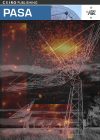Publications of the Astronomical Society of Australia
Volume 29
Number 4 2012
RESEARCH FRONTS: 1. Missing Satellites; 2. Supernovae and their Host Galaxies
Large-scale imaging surveys have been instrumental in finding the least luminous galaxies, uncovering inconsistencies between the CDM paradigm and galaxy properties, and reopening the debate about the building block scenario for the Milky Way. Progress in the field is discussed and attention drawn to future initiatives aimed at better understanding the phenomenon of 'ultra-faint dwarf galaxy'.
Dark-matter (DM) dominated dwarf and DM-free tidal dwarf galaxies coincide, thereby falsifying the current standard model of cosmology, which is incompatible with many other observations. Other cosmologies account for the data. Major problems with inflationary big bang cosmologies remain unresolved.
The photometric properties of Type Ia supernovae in the near-infrared from observations made over the last 30 years are reviewed. The data reveal considerable homogeneity, but also some fascinating differences. For all but the fastest declining objects, Type Ia supernovae are essentially perfect standard candles in the near-infrared.
The identity of the progenitors of type-Ia supernovae (SNe Ia) is a major puzzle. SN Ia rates are providing new clues, through the delay-time distribution (DTD) of these events. Recent measurements and analyses point to a ~t–1 DTD, suggesting that at least some SNe Ia result from double white dwarf mergers.
This review describes recent developments in the use and analysis of scattered-light echoes from luminous transient objects like supernovae. We review the state of ‘light echo’ research in the local Universe and outline the benefits and observational challenges of interpreting spectroscopy and spectroscopic time-series of light echoes.
Until recently, the venerable study of cosmic explosions was plagued by a wide luminosity gap between novae and supernovae. Serendipitous discoveries, archival searches and ongoing systematic surveys are yielding transients fainter, faster and rarer than supernovae. This paper reviews the discoveries and unique physics of transients that bridge this gap.
Surface brightness fluctuations are one of the most powerful techniques to measure the distance and constrain the unresolved stellar content of extragalactic systems. This article gives a historical background, reviews the basic concepts, presents a broad sample of investigations and discusses possible selection effects, biases, and limitations of the method.
We present an absolute-magnitude calibration for red giants using the colour–magnitude diagrams of the clusters M92, M13, M5, 47 Tuc, M67 and NGC 6791. The calibration is defined in the colour interval 0.75 ≤ (B – V)0 ≤ 1.50 mag and it covers the metallicity interval –2.15 < [Fe/H] ≤ +0.37 dex. 91% of the absolute magnitude residuals lie in the interval –0.40 < ΔM ≤ +0.40 mag. The mean and the standard deviation of the residuals are 0.05 and 0.19 mag, respectively.
Atmospheric modelling of the components of the visually close binary systems Hip70973 and Hip72479 was used to estimate their physical parameters. The model atmospheres were constructed using a grid of Kurucz blanketed models, and used to compute a synthetic SED for each component separately, and hence for the combined system, for comparison with the observational SED.
The universe is fine-tuned for life: of all the possible physical laws, parameters and initial conditions, the set that permits the evolution of intelligent life is very small. We review the scientific literature, from the classic works of Carter, and Barrow and Tipler, as well as more recent work.


